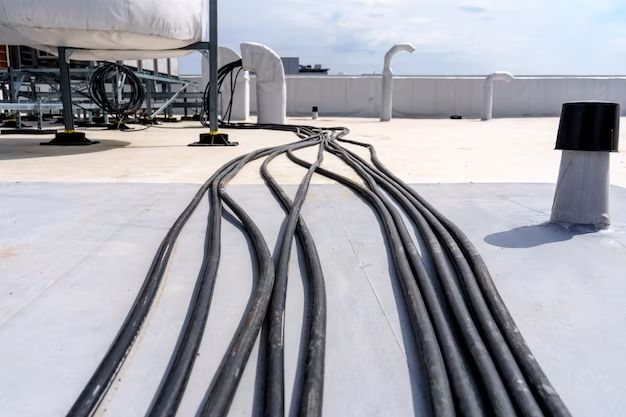Roof deicing cables, also known as roof heating cables, are a system designed to melt snow and ice buildup on rooftops. They work by running an electrical current through resistive heating cables, which are attached across the roof. The heat generated by the cables melts the snow and ice, allowing it to slide off the roof. Roof deicing cables can be an effective way to prevent dangerous ice dams and icicle formation in cold climates. However, there are some important factors to consider when determining if roof deicing cables are a good option.
Page Contents
Safety and Effectiveness
One of the biggest benefits of roof deicing cables is safety. By melting snow and ice, they can prevent heavy buildup and ice dams, eliminating the risk of ice or snow sliding off the roof unexpectedly. This protects people and objects below from being hit and damaged. The cables are also effective when installed correctly, providing reliable snow and ice melting across the entire roof surface.
That said, roof deicing systems do pose some safety concerns. The electricity running through the cables creates potential fire and electrocution hazards. Proper installation by a qualified professional is essential to prevent fires or shocks. Routine maintenance and inspection of the cables is also critical. Damage to the cables can allow water to seep in, shorting the system and creating dangerous situations.
Convenience
Roof deicing cables offer a high level of convenience compared to manual snow removal. Once installed, the system runs automatically, eliminating the need to clear snow after each storm. This saves time and avoids the risks of physical labor on potentially icy rooftops in the winter.
However, roof heating systems do require monitoring and maintenance for optimal performance. The cables and controls need to be checked before each winter to spot potential damage. Occasional clearing of heavy snow may still be required if the system cannot keep up during extreme storms. And power outages will render the cables inoperable until electricity is restored.
Costs
Roof heating cables are a significant upfront investment, with installation costs typically ranging from $10-$30 per square foot. The system size, roof pitch, cable spacing, and labor will impact the total price. Operating costs also need to be factored in, as the cables consume electricity when in use.
That said, over the long term roof deicing cables can pay for themselves by preventing costly roof repairs. Ice dams and heavy snow buildup cause significant damage like leaks, mold, and roof collapse. Avoiding these expenses can make the systems a sound financial investment for homes in snowy regions.
Average Costs of Roof Deicing Cables
| System Size | Average Cost |
|---|---|
| 1,000 sq ft | $10,000 – $30,000 |
| 1,500 sq ft | $15,000 – $45,000 |
| 2,000+ sq ft | $20,000+ |
Aesthetics
Roof deicing cables are mounted on top of the roof, so they have minimal impact on the home’s appearance and do not affect living spaces. The only visible components are the cables and control box. Cables can be painted to match the roof color and blend in. So for most homeowners, aesthetics are not a major concern.
However, cables may be visible from above on flat or low-pitched roofs. The lines across the roof surface could be considered unsightly by some. Homeowner associations may prohibit visible cables in their communities for this reason.
Environmental Impact
Operating roof heating cables does consume electricity, which leads to some environmental impacts depending on how that energy is generated. But the systems are fairly efficient and turn on only as needed during snowstorms. The carbon footprint is relatively small, especially compared to manual snow removal using fossil fuel-powered snow blowers and plows.
Professionally installed systems with good insulation can further minimize energy needs and environmental impacts. And roof heating combined with solar panels allows the cables to operate using clean, renewable energy. Overall, environmental impact should not be a major barrier.
Roof Type Compatibility
Roof deicing cables are compatible with most roof types, including asphalt shingle, metal, tile, and rubber. Effectiveness does depend on roof pitch and design. Steeper roofs allow snow and ice to shed more easily. Places where snow accumulates, like valleys and dormers, require careful cable placement. Flat roofs are the most challenging and may need higher-density cable layouts.
That said, cables can be designed to fit any roof with proper planning. The system needs to be tailored for the specific roof shape and material. As long as the cables make consistent contact with the roof, they will heat effectively. Proper installation is key regardless of roof type.
Maintenance Requirements
Roof deicing systems require some annual maintenance. Before each winter, the cables, controls, and connections should be inspected for damage. It is also smart to clear leaves, debris, and buildup from gutters to allow proper drainage once snow melts. Through the winter, the cables should be monitored for proper operation.
Beyond inspection and cleaning, the cables themselves don’t need much maintenance if installed correctly. But it is critical to get any damage repaired immediately by a professional. Even small cuts in the cable jacket can lead to system failure or fires. Regular maintenance helps prevent expensive repairs down the road.
Conclusion
Roof deicing cables offer an effective way to clear heavy snow and ice buildup from rooftops in cold climates. When properly installed and maintained, they can prevent dangerous ice dams, protect roofs from damage, and reduce the risks of manual snow removal. While the upfront cost is significant, roof heating systems provide long-term safety, convenience, and potential cost savings from avoided roof repairs.
Homeowners considering roof deicing cables need to weigh the benefits against the installation and operating costs carefully. Proper placement and setup tailored to the specific roof is critical to maximize effectiveness and safety. Overall, roof heating cables are a good option for most homes in snowy regions if budget and aesthetics allow.
